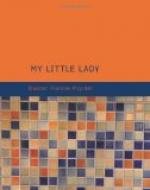She went in; it was a village church of the simplest description, very small, with plain wooden benches and confessionals, and a high altar with inexpensive decorations, in nowise remarkable. But hardly was Madelon inside the door, when she stood suddenly motionless, transfixed by a horrible terror that, weak and exhausted as she was, wholly seized and gained possession of her; for, raised in the middle of the aisle, covered with a black velvet pall and with a row of tall candles on either side, stood a coffin, with white embroidery of death’s heads on the pall, and little banners with painted death’s heads decorating every candle. To the terrified, speechless child, the skulls seemed to become animated—to grin; they seemed to move; the whole air was suddenly full of them, chattering, dancing, swarming round her; she tried to scream, but could not; she turned to fly from the dreadful, haunted spot, but with the first step she made, strength and consciousness gave way altogether, and she sank senseless to the ground.
Ten minutes later, a woman of the village, coming in to see the preparations for the funeral of Monsieur N——, lately one of the great proprietors of the neighbourhood, nearly stumbled over Madelon’s prostrate form. She started back, half uttering an exclamation of surprise and alarm; then, seeing that it was a child who was lying so still upon the stone floor, she knelt down by her, laid her head in her lap, and began rubbing her hands. Madelon was not quite unconscious, apparently, for she moved her head uneasily, and uttered a low moan. “She is not dead, at any rate,” muttered the woman, still chafing the cold little hands, while she studied




